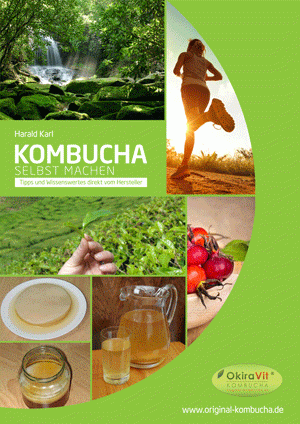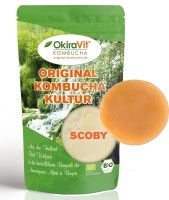![]() Download german PDF (free service) for print >here
Download german PDF (free service) for print >here
Kombucha homebrewing is becoming more and more popular. The original Kombucha tea mushroom and high-quality preparation liquid in sufficient quantity (Scoby) is the most important thing for this. Then only a good manual is needed as a companion on the way to delicious Kombucha, to be able to master all hurdles confidently.
Often, however, instructions for making kombucha do not provide sound information. Not infrequently, they contain inaccurate information, some even nonsensical and incorrect recommendations, with which the kombucha culture can even be damaged.
For this reason, our popular instructions, much praised by our customers, are available as an e-book and paperback edition (german). It contains our decades of experience in the production and care of Kombucha culture. In it, we show exactly how to circumvent all the common errors and how to easily overcome possible hurdles on the way to making your own kombucha.
Kombucha is not only the taste winner among fermented beverages. Its ingredients are legendary. Only those who brew kombucha themselves can benefit from the legendary effects of these numerous, vital ingredients. Commercially available Kombucha ready-to-drink beverages are usually strongly heated during the industrial production process and thus these valuable vital substances are completely killed. However, it is precisely these ingredients that make kombucha one of the most popular fermented beverages today.
Kombucha is probiotic, contains numerous antioxidants and is a naturally alkaline food. Kombucha has a distinct advantage over water kefir in that the residual sugar content in kombucha is significantly lower due to the longer maturation period and the quality of the microorganisms.
All of this makes kombucha a probiotic superfood!
In this guide, we also provide an overview and sound decision-making tools for buying a vital kombucha culture. This makes it easy to make the right choice with a good feeling and to enjoy homemade kombucha without a "bitter aftertaste" even in the long term.
Preparation of kombucha per liter: (take it all x 2 for 2 L etc)
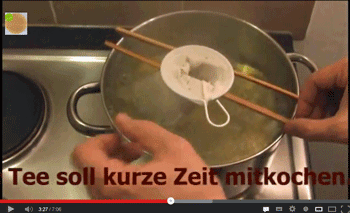 1. Bring water to a boil in a saucepan
1. Bring water to a boil in a saucepan
2. Pour about 3 g-10 g of tea in the boiling water
This can be green tea, black tea, fruit tea, herbal tea, or a tea blend. Briefly cook and about 20 minutes be drawn. Only then are important substances free (nitrogen) that are good for the fermentation process. It can therefore be a very light or a strong tea. Do not use artificial flavors or tea with a high content of essential oils (peppermint, sage): important. They disturb the fungal growth. It is always recommended to give a share to green tea. Especially this likes Kombucha.
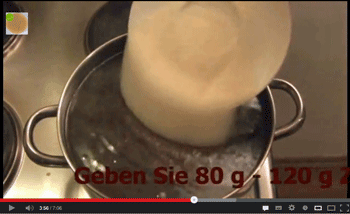 3. Now give 80 -120 g of sugar in the tea is still hot
3. Now give 80 -120 g of sugar in the tea is still hot
Then it dissolves better. More sugar may taste unpleasant. The sugar is converted by fermentation into valuable ingredients for the most part. (The more acidic the less residual sugar) Do not let it become be too acidic. Kombucha should to remain a healthy delicious drink!
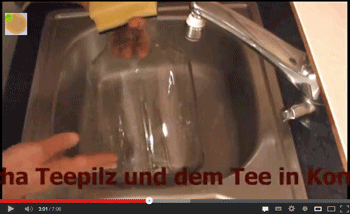 4. Clean the fermentation vessel and all equipment to be used for the production thoroughly
4. Clean the fermentation vessel and all equipment to be used for the production thoroughly
Very thoroughly remove detergent residues, residues from rinse well after cleaning in the dishwasher. It is enough to clean the glass container only every second approach as described (Glass container with max. 80 ° C).
Warning: The glass container breaks when it is re-cooled too quickly with cold water. Therefore: let it cool slowly and without cold water. Hot glass is extremely sensitive to shock. Do not bump and not stir the glass with a metal spoon in hot tea. In case of breakage risk of injury!
5. Allow to cool the tea to 20 - 30 ° C
Cooled filling into the fermentation vessel. At higher temperatures, the fungus can die!
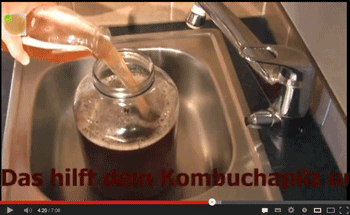 6. Pour about 10 % (100 ml) finished self-made Kombucha into the cooled tea into the fermenation vessel.
6. Pour about 10 % (100 ml) finished self-made Kombucha into the cooled tea into the fermenation vessel.
There is a sufficient amount of starter-fluid at each delivery of an Original-Kombucha-Tea-Fungus from us. The starter-fluid is also very extremely effective for defense against foreign pathogens of the culture.
Fill the fermentation vessel only up to the level where it becomes narrower. The Kombucha tea fungus needs to grow as large a surface on which it can expand.
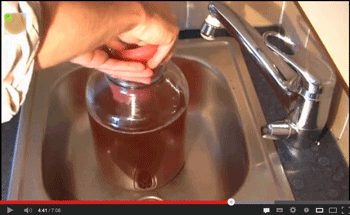 7. Put the Kombucha tea fungus with the lighter, flat side up, into the fermentation vessel with the tea
7. Put the Kombucha tea fungus with the lighter, flat side up, into the fermentation vessel with the tea
If the wrong side is up it is not dramatic. If the fungus falls on the ground of the vessel there will grown a new fungus over the entire surface. Starting at about 0.3 cm the newly formed fungus can be used alone. For a successful fermentation process, the diameter is more important than its thickness. The older fungus can remain in the fermentation vessel but should be disposed of when it gets coloured dark . (The old fungus can be used for make a face cream. See "Recipes" on our website.) Dark discolored areas simply cut out.
The fermentation vessel should have a straight diameter. Fermentation vessels with "belly" are not suitable. In it, the fungus can not spread enough and "breathe."
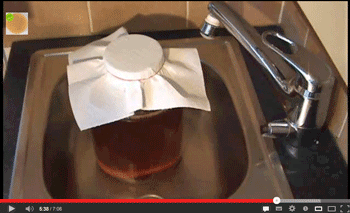 8. Cover the fermentation vessel with a cloth and fasten it with a rubber band
8. Cover the fermentation vessel with a cloth and fasten it with a rubber band
This is very important in order to prevent insects and mould infestation. The best paper is this of a household "kitchen roll". It works well with cloth diaper or a double layer of gauze also, but is not as easy to clean it after use.
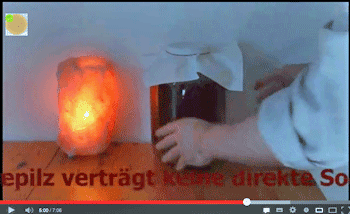 9. Put the fermentation vessel to a warm place (preferably not below 15 ° C and above 30 ° C, ideally 23 ° C)
9. Put the fermentation vessel to a warm place (preferably not below 15 ° C and above 30 ° C, ideally 23 ° C)
Heat plates are unnecessary. Avoid cigarette smoke. Direct sunlight is harmful. Daylight does not harm Kombucha contrary to frequent assertions. Darkness is not better. You might want to wrap aluminum foil for light protection to the Gärglas. In this connection is also the further misconception that the use of heavy earthenware vessels led to better results. This effort can be saved.
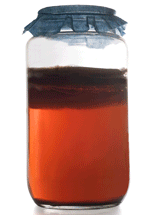 10. Let it to rest for about 5 -14 days
10. Let it to rest for about 5 -14 days
Do not move the fermentation vessel unnecessarily. Movement hinders the uniform growth of a new layer mushroom. The longer Kombucha matures, the more acid is produced. A sweet and most like note is obtained after about 5 days. Higher ambient temperature (in summer) is accelerating the ripening process.
Tip: If Kombucha is made more acidic than you wanted syrup is a great way for more sweetness and fruity flavors. Also for delicious kombucha drinks with mineral water a tangy treat.
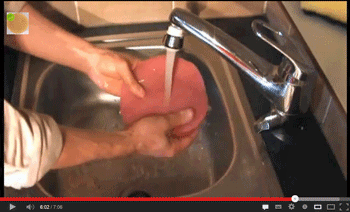 11. Remove the tea fungus with thoroughly cleaned hands and wash it off with lukewarm or cold water
11. Remove the tea fungus with thoroughly cleaned hands and wash it off with lukewarm or cold water
In the meantime store the fungus in a clean container made of glass or ceramic.
No contact with metal. The metal oxidizes with the acidity of Kombucha and harms the kombucha-drink and the tea fungus.
(On the image and in our video you can see the Kombucha-FRUIT fungus made from fruit tea. Therefore the reddish color comes from. From green tea the tea fungus is beige.)
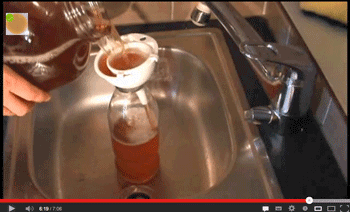 12. The finished Kombucha drink through a sieve into glass or plastic bottles pour
12. The finished Kombucha drink through a sieve into glass or plastic bottles pour
Who is not interfered with the byproducts of fermentation (fungal components), can drink them. They are completely harmless. At the bottom of the fermentation vessel have accumulated healthy and desirable yeast cells. They lead to clouding when they are stired. They can be drunk.
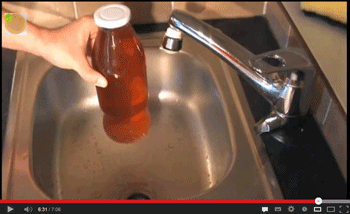 13. Close the filled bottles and store it in the refrigerator
13. Close the filled bottles and store it in the refrigerator
Here's Kombucha stable 1-2 weeks. In the later fermentation developes tingly carbonation. You might want to add mineral water. With some vitamin C (ascorbic acid) per liter, the stability can be increased.
14. Start again as described a new batch
In the secondary fermentation / bottle fermentation additionally sparkling carbonic acid is formed. The fermentation process continues in the refrigerator and does not stop, but slows down with the appropriate changes. For more on the popular secondary fermentation (bottle fermentation), download our booklet above. Then kombucha becomes tangy and a flavorful adventure.
Answers to all questions about Kombucha, see "Kombucha selbst machen," our reference for all who make Kombucha itself and in our FAQ.
Source of supply
The Original-Kombucha-Tea-Fungus with the original starter fluid and growing-guarantee of organic quality of the Zugspitze, certified by the Central Institute for Nutrition and Food Research (ZIEL) of the University (TU) of Munich is only available from:)
(This instruction manual for use is an extract supplemented from our book: "Kombucha selbst machen - the reference book for all who make Kombucha itself" ©. Available as immediate download or as pocketboook to shipping in our online store.)

